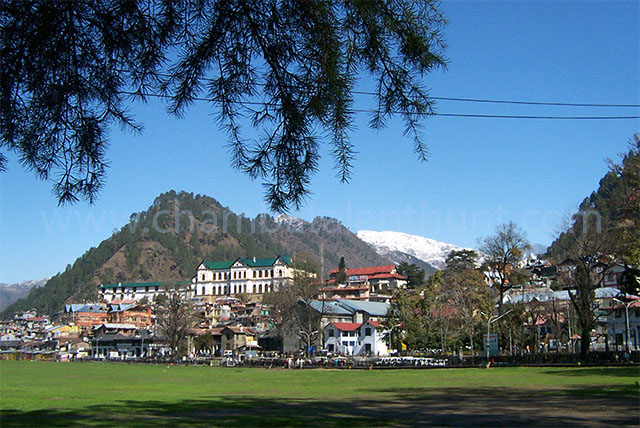- Chambatalenthunt2013@gmail.com
-
 +91-9816631006, +91-9418333592
+91-9816631006, +91-9418333592
Chamba Millennium Town

Chamba, the land of god is know as "SHIVA" - "BHUMI", because of the abode of lord Shiva on Manimahesh Kailash at Brahmaur. Chamba district of Himachal Pradesh is a 'Dreamland', which is culturally rich and inhabited by colourful people. The historians have described "CHAMBA - ACHAMBA", Chamba is an ancient town in the Chamba district of Himachal Pradesh. llChaugan, the grassy meadow at the heart of the town, is also the center of its cultural activities. In July/August of each year Located at an altitude of 996 metres (3,268 ft) above mean sea level, the town is situated on the banks of the Ravi River, at its confluence with the Sal River. The town has a large number of temples and palaces, and hosts two popular jatras (fairs), the "Suhi Mata Mela" and the "Minjar Mela", which last for several days and involve music and dancing. Still intact a fine group of six ancient shikhara style stone temples (dating back to 8th Century) are dedicated to lord Shiva, Vishnu and Other Deities. Among them the richly carved Lakshmi-Narayan temple is the oldest Structure. Other Evidence of Chamba’s heritage can be seen in the famous paintings from the Kangra, Basholi and Chamba schools at the Bhuri Singh Museum, as well in the murals and the other artifacts at the Rang Mahal Palace.Chamba is surrounded on all sides by lofty hill ranges and the altitude in this entire mountainous terrain of the intermediary zone of western Himalayas ranging from 600 to 6400 meters above mean sea level. Mountain system and ranges in association with rivers basins, determine the natural division of the district, which happens to be the most important factor in the evolution of cultural habits, language and traits of its inhabitants. These natural division (valleys) are separated from one another by well defined snowy ranges, which is nearest the plains, is called the outer Himalaya or Dhauladhar (white crest or white range) and in kangra it is generally spoken in the mid-Himalaya or Pangi range (Pirpanjal) between the basin of the Ravi and Chandrabhaga or Chenab. The third is the inner Himalaya or Zanskar range between the Chenab and Indus.
Chamba is the oldest and historical important town in the whole region. There stands a group of six stone temples in nagara style, arranged in a row north to south. The temple of the Lakshmi Nath group, Hari Rai, (Vishnu Chaturmurti), Champavati, and Bajreshwari are very old and constructed in the highly evolved nagara style.
In the Hatnala quarter of the town, The Lakshmi Narayan temples complex, devoted to the Vaishnavite sect, includes the main Lakshmi Narayan temple, built in the 10th century by Raja Sahil Verman. Lakshmi Narayan locally called Lachhmi Nath, the principle deity of Chamba, The garbhgriha contains white marble image of Vishnu in his Vaikunth aspect with four faces, decked with golden ornaments, which were presented in reverence by Rajas of Chamba during their reigns in the past. Raja Sahil Varman erected the temple of Lakshmi Narayan shortly after the foundation of Chamba town, the new capital of the kingdom.
The nagara style stone temple of Vishnu, Chaturbhuji - murti, is located in the north west corner of the main chougan(ground) near the Delhi gate. which became the main entrance to the town by the end of 19th century AD. The steep path fixed with cobbled stone leads to the Shitla Bridge. The god is locally called Hari Rai.
According to the legend that this is the spot where Rani had takenrest for a while to see for the last time the Chamba town below. A very simple rudimentary form of memorial, pindi, daubed with vermilion known by the name of SUHI MATA. Now this stone pindi is embellished by abrass mask and is known by the name of SUHI DEVI, SUHI BHAGVATI.
The Chambayals remain sentimental about the Chaugan as the boby of deseased is laid to rest for a while in the Chaugan on its journey to the crematorium in the funeral procession. The large green space is a unique in this hilly town, but with the passage of time it lost its grandeur and divided into five level mydans.
Rangmahal was laid by Raja Umed Singh(1748-64),who could complete only the mighty sub- structure with its three front and part of the present ground floor. The Rangmahal formerly the residence of Rajas, Panis and other ladies of the harem was tastefully decorated with finely carved wooden doors windows, ceilings, galleries, and projected balconies. The living and puja rooms and corridors were decorrated with mural painting of exquisite workmanship in the lucid Pahari style.
Now a college, this imposing building once housed Chamba's ruling family. Much of the original craftsmanship can still be seen.
Named after Raja Bhuri Singh of Chamba, this is a treasure house of Chamba's rich past. The exhibits include copper plates, murals, doorways, costumes, paintings and stone carvings. click the link of Bhuri Singh Museum Chamba Website (www.bhurisinghmuseumchamba.in)
Over a century old, this is a charming dressed stone structure with lancet windows.
Its 84 ancient temples at a height of 2141m are well known. It is also the summer home of the nomadic Gaddi people.
This sacred lake (4183m) is associated with Lord Shiva and is a site of annual pilgrimage from mid of August to mid of September each year. Distance from Bharmaur is 28 Km.
An attractive temple to Shakti Devi is located at Chatrari on highway Chamba to Bharmour